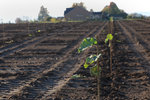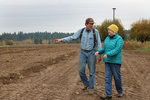

Hazelnuts are having a resurgence at Baurs Corner Farm in Ridgefield.
Workers from Birkenmeier Farms, Inc., a hazelnut nursery in Canby, Oregon, helped Baur farm owners Rob Baur and Sue Marshall plant 3,2000 hazelnut trees Nov. 8.
“What’s amazing is they planted more than 3,000 trees in six-and-a-half hours,” Baur said of the Birkenmeier crew. “An army came in, and boom, they were gone by 2 p.m. It was amazing, and it was only $1.35 a hole.”
When the Baur family purchased the Corner Farm in 1960, Baur recalls planting lots of pear trees with his brother and father. The ordeal took weeks, if not months, to do by hand.
“Some people have a mountain tavern or a beach house, we had a 30-acre farm with 4,000 pear trees. That’s how I spent my summer vacations, my Christmas vacations, my spring break vacations — every weekend,” Baur said.
Slowly, the pear industry began to sour on the Baurs. By 2001, the family had to sell some of its assets because the price paid by the processor wasn’t enough to cover the farming costs.
“We leased our land to other farmers until we could muster the time and the resources to reinvest in the farm,” Baur said.
Hazelnuts were also a bust for a period of time, according to Sue Marshall.
“Once a prominent crop in Clark County, hazelnuts fell victim to eastern filbert blight,” she said. “It took a heavy toll on orchards in Clark County and spread south to Oregon threatening the hazelnut industry.”
Through genetic research by Oregon State University, a disease-resistant gene was discovered.
Now that hazelnuts are having a renaissance, Baur and Marshall are hoping to cash in.
“When they bloom, the pollen is dispersed and it can’t be too dry, it can’t be too cold and it can’t be too wet,” Baur said. “So that’s why you can’t grow them in California, it’s too hot and dry. You can’t grow them in the midwest because it’s freezing cold. It has to be around 45’ latitude and near an ocean to moderate the climate. The Willamette Valley is just the perfect spot.”
Baur and Marshall expect to have their first commercial harvest in five years, and then full production in 10 years.
“Our hope is that Clark County farmers will take a look at hazelnuts as an economically viable crop and plant additional acreage so there would be a critical mass of growers sharing equipment and expertise, and protecting farmland into the future,” Baur said.